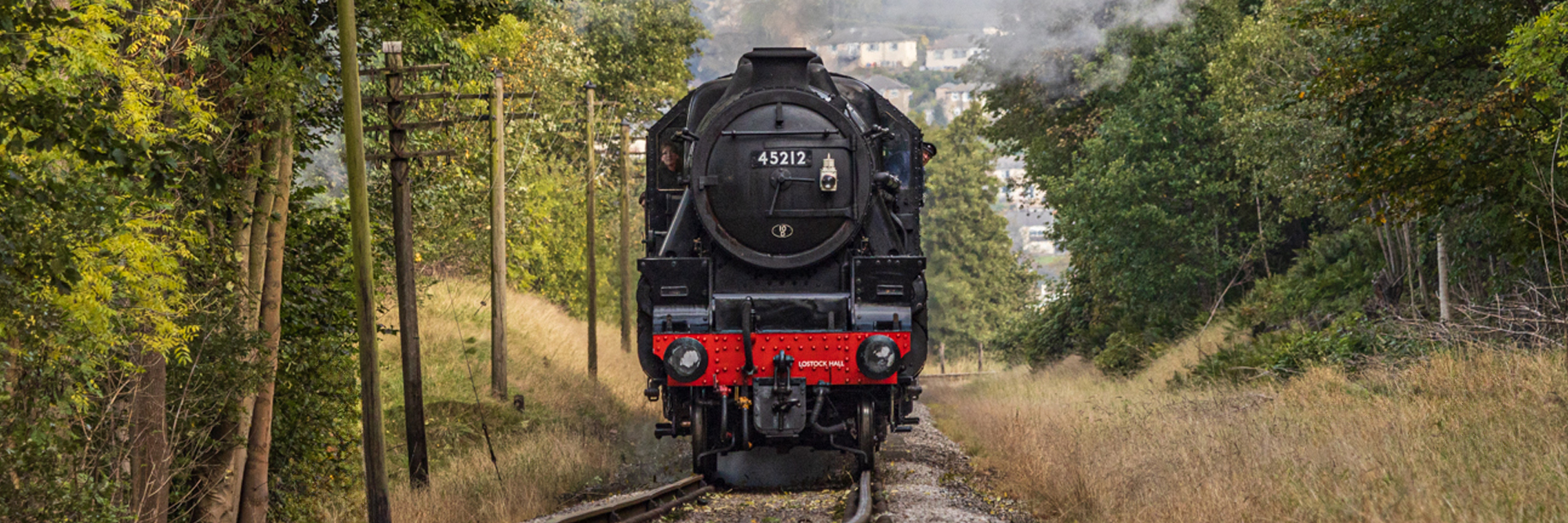An engine from the last days of steam on BR
Running from Preston to Blackpool, 45212 has the distinction of heading the final steam-hauled revenue-earning service for British Railways on 4th August 1968 before entering preservation directly from British Railways.
From 1935 to 1968, 33 years of national service
This engine class was designed by William Stanier (later Sir William) in 1934. They were always painted in mixed traffic-lined black and, with a power rating of 5, became known by enthusiasts as Black 5’s. By the time the last one was produced in 1951, there were 842 examples. They were widely used and could be seen virtually all over the LMS system. After the nationalisation of the railways in 1948, the class spread further afield, including being used by the Southern Region in the 1950s after the forced withdrawal of some of its express engines due to a traction shortage.
Over half of the class was produced by two private manufacturers for the LMS: Vulcan Foundry and Armstrong Whitworth. As LMS no. 5212, our Black 5 was produced by Armstrong Whitworth at their works in Newcastle in 1935 and gained the British Railways number 45212 after nationalisation. The engine was delivered new to Low Moor shed in Bradford (West Yorkshire), so may even have passed through Keighley during this stage of its career. Whilst in British Railways’ ownership, the engine was ‘shedded’ at Fleetwood (1948 – 1964), Carnforth (on two separate occasions, 1964 – 1965, 1965), Speke Junction (Liverpool, 1965), Carlisle (Kingmoor, 1965 – 1968) and Lostock Hall (Preston, 1968). It was from this latter shed that the engine was withdrawn from traffic in the final month of steam traction on the national network.
Running from Preston to Blackpool, 45212 has the distinction of heading the final steam-hauled revenue-earning service for British Railways on 4th August 1968 before entering preservation directly from British Railways.
Into preservation, restoration and back onto the national network
Withdrawn in August 1968, 45212 was purchased by working members, negotiated by the late Ron Ainsworth, for use on the KWVR where it arrived in October of that year. On arrival, it was covered in wallpaper as part of an advert for Solvite wallpaper paste. In 2000, it moved to the North Yorkshire Moors Railway, where Mr Peter Best overhauled it. It remained at Grosmont until July 2011, when it moved back to the KWVR a few months before its boiler certificate expired in October 2011.
Two years later, the KWVR entered into a unique 10-year agreement with the Bury-based engineering company Riley & Son (E) Ltd. to rebuild 45212 to mainline condition. Its nine years of reliable service on the NYMR under Peter Best’s guidance undoubtedly led to its consideration for mainline operation by the new caretakers. As part of the agreement, the engine will spend three months each year on KWVR passenger duties.
With its overhaul complete, 45212 returned to the KWVR in July 2016 and was repainted in the late British Railways livery it carried in 1968. Following a successful steam test, it entered service on the KWVR in time to haul services at the Railway’s Beer & Music Festival. Returning to Riley & Sons (E) Ltd, 45212 was readied for mainline operation, including the fitting of air brakes and, following running-in turns on the East Lancashire Railway at Bury, travelled to Carnforth for trials before operating on the mainline.
In April 2017, 45212 headed north to Scotland to operate the Jacobite steam-hauled trains on the West Highland line. 2018 saw the locomotive based at Southall as a standby for Cathedrals Express and was found operating over various routes in South England. Having taken part in Southern metals, 45212 headed north to operate again between Fort William and Mallaig on the West Highland line. From 2019 onwards, during the summer season, 45212 has headed North with Riley & Sons (E) Ltd to haul the Jacobite through the Highlands of Scotland, returning to the KWVR during the winter months to haul the railway’s festive trains, take part in the Steam Gala and for its Winter maintenance.
data file
| Built: | 1935 Newcastle |
| Boiler Pressure: | 225 psi |
| Tractive Effort: | 25,450 lbf |
| Weight: | 72.1 tons engine 53.65 tons tender |
| Valve Gear | Walschaerts |
| Cylinders: | 18½” x28″ Outside |
| Numbers carried during working career: | LMS 5212, BR 45212 |
